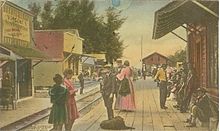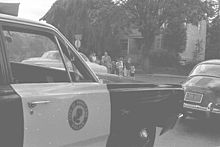- Rubbernecking
-
"Rubberneck" redirects here. For the Toadies album, see Rubberneck (album).
 Long Beach, Washington, circa 1909, looking north along the line of the Ilwaco Railway and Navigation Company at an early tourist area called "Rubberneck Row"
Long Beach, Washington, circa 1909, looking north along the line of the Ilwaco Railway and Navigation Company at an early tourist area called "Rubberneck Row"
Rubbernecking describes the act of gawking at something of interest. It is often used to refer to drivers trying to view the carnage resulting from a traffic accident. The term refers to the craning of a person's neck in order to get a better view.[1]
Rubbernecking has also been described as a human trait that is associated with morbid curiosity.[2] It can be the cause of traffic jams (sometimes referred to as "Gapers' blocks"), as drivers slow down to see what happened in a crash. It is also a cause of accidents as drivers become distracted and change their rate of travel while other drivers are also distracted. Rubbernecking has also come to be used more generally to describe voyeuristic interest in someone else's "business" or difficulties.
Contents
History
The term rubbernecking was an Americanism coined in the 1890s to refer to tourists.[3] H.L. Mencken said the word rubberneck is "almost a complete treatise on American psychology" and "one of the best words ever coined".[3]
By 1909 rubbernecking was used to describe the wagons, automobiles and buses used in tours around American cities,[3] and through their Chinatowns.[4] The tours included a megaphone-wielding individual offering commentary on the urban landscape.[4] Chinese Rubbernecks was the title of a 1903 film.[4]
One writer described the "out-of-towners" stretching their necks to see New York while having misinformation shouted at them, and artist John Sloan depicted them as geese in a 1917 etching called Seeing New York.[3] Tickets were sold by hawkers, touts and steerers were used to market the rubbernecking tours, also known as "gape wagons" or "yap wagons."[3]
When phone lines were shared as "party lines" the term rubbernecking applied to someone who listened in on the conversation of others. [5]
The term "rubberneck" is used in Ireland to refer to a person acting in a foolish or silly manner.
Rubbernecking and the automobile
The term is often used to refer to the activity of motorists slowing down in order to see something on the other side of a road or highway, often the scene of a traffic accident. According to a 2003 study, rubbernecking was the cause of 16 percent of distraction-related traffic accidents.[6] It features in the book 100 Most Dangerous Things in Everyday Life and What You Can Do About Them and is said to be factored into highway design.[6] The book advises that the safest course when there are flashing lights and an accident is to keep moving, "there is nothing to see here". Rubbernecking's impact on traffic has been the subject of studies.[7]
Prevention
In the Netherlands and the United Kingdom, incident screens have been designed that can be erected around vehicle accidents to discourage rubbernecking.[8][9]
References
- ^ Rosalind Fergusson, Eric Partridge, Paul Beale Shorter slang dictionary Routledge, 1994 ISBN 0-415-08866-6, 9780415088664 241 pages page 178
- ^ Daniel P. Franklin [Politics and film: the political culture of film in the United States] Rowman & Littlefield Publishers, 2006 University of Michigan ISBN 0-7425-3808-7, 9780742538085 223 pages page 96
- ^ a b c d e Irving Lewis Allen The City in Slang: New York Life and Popular Speech Oxford University Press US, 1995 ISBN 0-19-509265-1, 9780195092653 320 pages
- ^ a b c Peter X. Feng [Screening Asian Americans] Rutgers University Press, 2002ISBN 0-8135-3025-3, 9780813530253 308 pages
- ^ Frederic Gomes Cassidy, Joan Houston Hall Dictionary of American regional English Harvard University Press, 2002 ISBN 0-674-00884-7, 9780674008847 1040 pages page 657
- ^ a b Laura Lee 100 Most Dangerous Things in Everyday Life and What You Can Do About Them July 1, 2004 Murdoch Books ISBN 1-74045-422-7 ISBN 978-1-74045-422-3 240 pages page 161
- ^ Jonathan P Masinick An Analysis on the Impact of Rubbernecking on Urban Freeway 2004 University of Virginia
- ^ "Rubbernecking prevention using incident screens"
- ^ "Incident Screens - Functional Specification"
Categories:- Slang expressions
Wikimedia Foundation. 2010.

